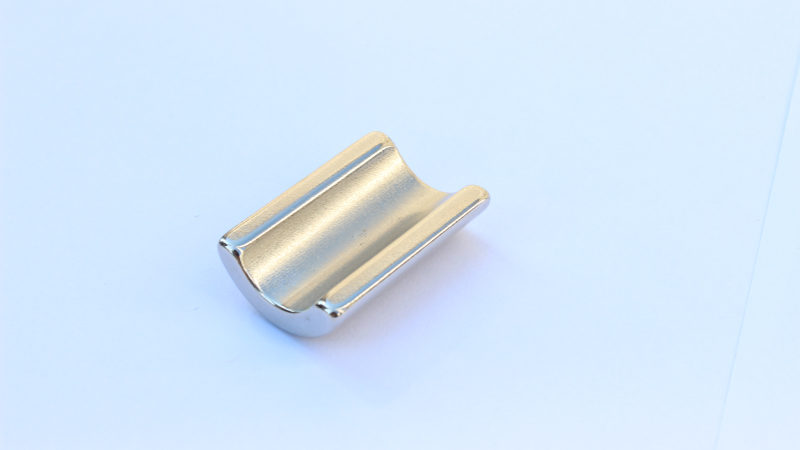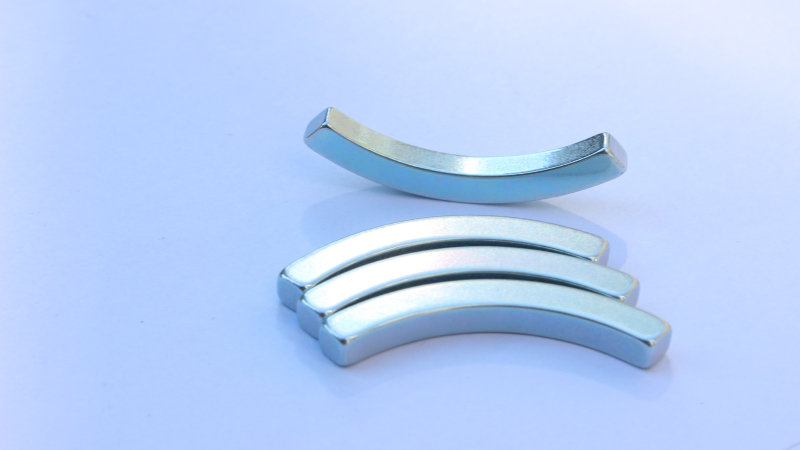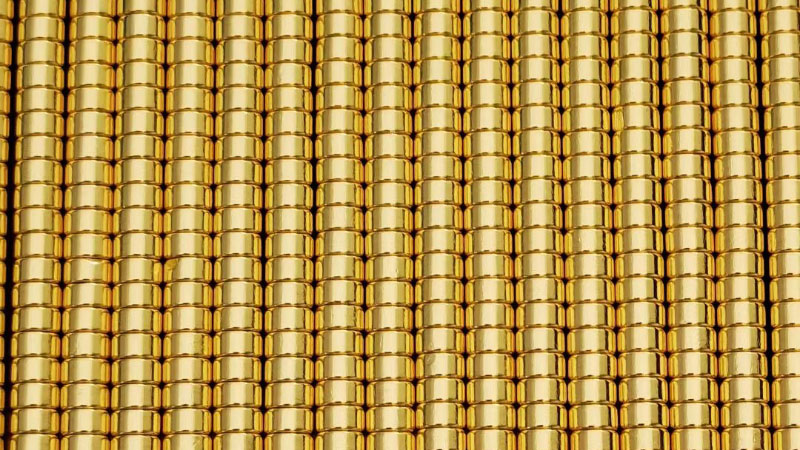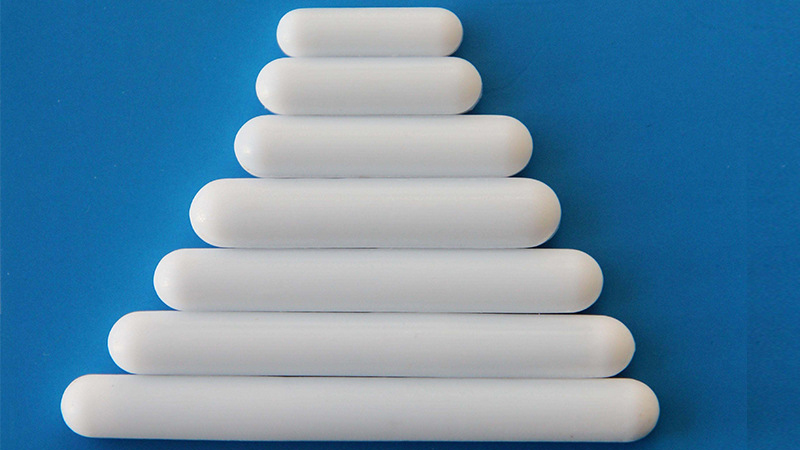Sintered neodymium iron boron (NdFeB) permanent magnet material is produced through a powder metallurgy process and has relatively active chemical properties.
It is prone to corrosion due to tiny pores and the presence of the Nd phase, which can lead to the decay and loss of magnetic properties over time. This can negatively impact the performance and lifespan of the machine in which it is used.
Therefore, it is essential to apply strict anticorrosive treatment to sintered NdFeB magnets before use to protect them from corrosion and ensure their optimal performance.
Coating Necessity Of Sintered NdFeB Magnets?
There are several reasons why sintered neodymium-iron-boron (NdFeB) magnets may need a coating:
- Protection against corrosion: As mentioned previously, sintered NdFeB magnets are prone to Nd oxidation in the air, which can lead to corrosion and loss of magnetic properties. A coating helps to protect the magnet from the corrosive effects of the environment.
- Wear resistance: Sintered NdFeB magnets can be subjected to high levels of wear and friction, particularly in applications that move or slide against other surfaces. A coating can help to reduce wear and extend the lifespan of the magnet.
- Improved performance: In some cases, a coating may be applied to improve the magnet’s performance. For example, a gold coating can improve the magnet’s electrical conductivity, while a titanium coating can increase its resistance to high temperatures.
- Aesthetics: In some applications, the appearance of the magnet may be important. A coating can be applied to give the magnet a specific color or finish, such as a shiny or matte appearance.
Different Coating Processes For Sintered NdFeB Magnets?
Several coating processes can be used to protect NdFeB (neodymium iron boron) magnets from corrosion and/or improve their performance in specific applications. Some standard coating processes for NdFeB magnets include:
- Electroplating is a process in which a thin layer of a metallic coating is deposited onto the surface of the magnet using an electrical current. This process often applies nickel, zinc, or gold coatings to neodymium magnets. Electroplating is a widely used coating process because it is relatively simple, quick, and cost-effective. It is also capable of producing thin, uniform coatings with good adhesion to the substrate
- Chemical plating is a process in which a thin layer of a coating is applied to the surface of the magnet by reacting a chemical solution with the surface of the magnet. This process often applies zinc or tin coatings to neodymium magnets.
- Electrophoresis is a process in which a sample containing the molecules to be separated is placed in a gel matrix, and an electric current is applied. This process is often used to separate and purify biological molecules, but it can also apply thin coatings to neodymium magnets.
- Painting or spraying is a process in which a coating material is applied to the surface of the magnet using a brush, roller, or spray gun. This process often applies epoxy or silicone rubber coatings to neodymium magnets.
- Vapor deposition is a process in which a thin layer of coating material is applied to the surface of the magnet by vaporizing the material and depositing it onto the surface. This process often applies thin, conformal coatings such as parylene to neodymium magnets.
| Coatings | Coating Processes | Coating Thickness | Hardness | Humidity- Resistance | Salt-Tolerance | Adhesion | Insulativity | Heat-resistance Temperature |
| Phosphating | Chemical Plating | 5-15 | / | Great | Good | Excellent | / | / |
| Zinc | Electroplating | 15 | HV20 | Excellent | Great | Great | / | <160°C |
| Zinc | Chemical Plating | / | / | Excellent | Good | Great | / | <150°C |
| Nickel | Electroplating | 10-20 | HV350 | Excellent | Great | Great | / | <200°C |
| Nickel | Chemical Plating | / | / | / | / | / | / | <180°C |
| Copper | Electroplating | 10-20 | / | Great | / | Great | / | <160°C |
| Epoxy | Electrophoresis | 10-30 | 4H | Great | Great | Great | Excellent | <150°C |
| Epoxy | Spraying | 5-15 | 3H | Great | Great | / | Excellent | <130°C |
| Aluminum | Vapor Deposition | 5-20 | HV20 | Great | Great | Great | / | <500°C |
| Aluminum | Spraying | 5 | 4H | Great | Great | Great | / | <180°C |
| Polyxylene | Vapor Deposition | 5 | 2H | Great | Great | Good | Excellent | / |
Coating Options For Sintered NdFeB Magnets
Nickel (Ni-Cu-Ni):
Ni-Cu-Ni is a three-layer coating consisting of layers of nickel and copper, with a layer of nickel on top.
Nickel is a magnetic and conductive material, and it is often used as a coating to protect metal surfaces from corrosion and wear. The nickel coating has a shielding effect, which can help block or reduce the amount of electromagnetic radiation that passes through it. This can be beneficial in certain applications where electromagnetic shielding is essential, such as in the electronics industry.
Ni-Cu-Ni coatings also strongly resist humidity and heat, making them well-suited for use in environments with these factors. They are also known to withstand high pressure and accelerated aging tests, making them suitable for applications where the metal is subjected to high-stress levels or long-term exposure to harsh conditions.
Overall, Ni-Cu-Ni coatings are a good choice for customers with higher requirements for their products’ appearance and internal performance, particularly in environments with condensation or other atmospheric conditions that could affect the long-term stability of the product.

Zinc plating (Zn):
Zinc is a one-layer coating known for its self-sacrificing properties, meaning that it will oxidize and turn white on the surface when exposed to the environment, creating a durable layer of protection.
Zinc is a non-magnetic material often used as a coating to protect metal surfaces from corrosion. The zinc coating has good resistance to salt spray, which means it can withstand exposure to saltwater environments without corroding. However, the coating is prone to producing powder on the surface of the metal over time, which can be a problem in applications where the surface needs to be smooth or free of particles.
In addition, zinc coatings have limited corrosion resistance against short-term contamination discoloration, which means they may lose their corrosion protection if exposed to specific contaminants. Therefore, zinc coatings are generally best suited for environments where only slight corrosion may occur rather than environments with a high corrosion risk.
Color zinc coatings are a type of zinc coating that has improved corrosion resistance compared to blue-white zinc coatings. Color zinc coatings are often used in more severe atmospheric environments, such as environments with a risk of organic corrosion.

Stannum (NiCuNi+Sn):
NiCuNi+Sn coatings are a type of electroplated coating that consists of a layer of NiCuNi (a layer of nickel, a layer of copper, and a top layer of nickel) with a layer of tin applied on top.
These coatings are known for their good appearance and weldability and are often used in applications where electrical contact is required, and the surface needs to be weldable.
Argentum (NiCuNi+Ag):
NiCuNi+Ag coatings, also known as Argentum coatings, are a type of electroplated coating that consists of a layer of NiCuNi (a layer of nickel, a layer of copper, and a top layer of nickel) with a layer of silver applied on top.
These coatings are a good choice for customers who need a coating with a good appearance, weldability, and low contact resistance. Still, they may have limitations in applications where resistance to surface discoloration is a concern. They are particularly well-suited for applications requiring electrical contact, and the surface needs to be weldable.

Gold (NiCuNi+Au):
NiCuNi+Au coatings are a type of electroplated coating that consists of a layer of NiCuNi (a layer of nickel, a layer of copper, and a top layer of nickel) with a layer of gold applied on top.
These coatings are known for their good decoration, resistance to color change, and low contact resistance, but they are also relatively expensive.

Black epoxy (BE):
Epoxy coatings are a good choice for magnets where an excellent adhesive bond is required and some resistance to moisture, heat, and salt spray is desired.
Examples of such applications include wind turbines and traction motors in the rail industry.

Plastic (ABS):
ABS plastic is a highly corrosion-resistant coating applied to magnets using an injection molding process. It is available in multiple colors.
Teflon (PTFE):
Teflon is a highly corrosion-resistant and slippery coating applied to magnets using an injection molding process. It is known for its ability to withstand harsh environments.

Passivation:
Passivation can be used as a temporary coating for metal surfaces to provide some corrosion protection, but it is generally not considered a permanent coating solution.
Phosphate:
Phosphate coatings can be used as a temporary coating for metal surfaces to improve the adhesion and appearance of paint or other coatings and to provide some level of corrosion protection until a more permanent coating can be applied.
| Coating | Typical Thickness | Color | Salt Spray Test/Hours |
| Ni+Cu+Ni | 10-20um | Bright Silver | 24-72hrs |
| Ni+Cu+Ni | 10-20um | Bright black | 48-96hrs |
| Zn (Blue-White) | 5-8um | Blue white | 16-48hrs |
| Zn (Color) | 5-8um | Color | 36-72hrs |
| NiCuNi+Sn | 10-25um | Silver | 36-72hrs |
| NiCuNi+Au | 10-20um | Gold | 12hrs |
| NiCuNi+Ag | 10-20um | Silver | 12hrs |
| Epoxy | 10-20um | Black/Grey | 48hrs |
| NiCuNi+Epoxy | 15-30um | Black/Grey | 72-108hrs |
| Zn+Epoxy | 15-25um | Black/Grey | 72-108hrs |
| Passivation | 1-3um | Dark grey | Temporary protection |
| Phosphate | 1-3um | Dark grey | Temporary protection |
Zinc Plating vs. Nickel Plating
Zinc and nickel plating are two common electroplated coatings that can be applied to neodymium magnets. These two types of coatings have some differences in their properties and applications.
- Appearance:
Zinc coatings have a matte finish and are prone to producing powder on the surface of the magnet over time, while nickel coatings have a shiny, metallic appearance. Customers with high requirements for their products’ appearance may generally choose nickel coatings, while those with lower requirements may choose zinc coatings.
- Corrosion Resistance:
Zinc is an active metal that can react with acid, which means that zinc coatings have poor corrosion resistance compared to nickel coatings. On the other hand, nickel coatings have good corrosion resistance due to the properties of nickel, which makes them well-suited for use in environments with a risk of corrosion.
- Hardness:
Nickel coatings are generally harder than zinc coatings due to the properties of the two metals. Nickel is a relatively hard and strong metal, while zinc is softer and more prone to deformation. As a result, nickel coatings are less prone to scratches, dents, and other types of damage than zinc coatings.
- Service Life:
The corrosion resistance of zinc coatings is generally lower than that of nickel coatings, which means that zinc coatings may have a shorter service life. This is because zinc coatings may peel or corrode over time, leading to oxidation of the magnet and reduced magnetic performance.
- Price:
Zinc coatings are generally less expensive than nickel coatings. In general, the price of NdFeB magnet coatings ranges from low to high in the following order: zinc plating, nickel plating, and epoxy plating.
Conclusion
Thank you for reading this post about coatings for sintered NdFeB magnets! As a leading manufacturer of high-quality magnets, JDA Magnet Manufacturer offers a wide range of coatings to meet the specific needs of our customers.
If you need sintered NdFeB magnets with a special coating, we encourage you to reach out to our team at JDA Magnet Factory. Our experienced team is here to help you choose the best coating for your application and provide you with the highest-quality magnets.
Thank you for considering JDA Magnet Factory for your magnet needs. We look forward to working with you and helping you find the perfect coatings for your sintered NdFeB magnets.
